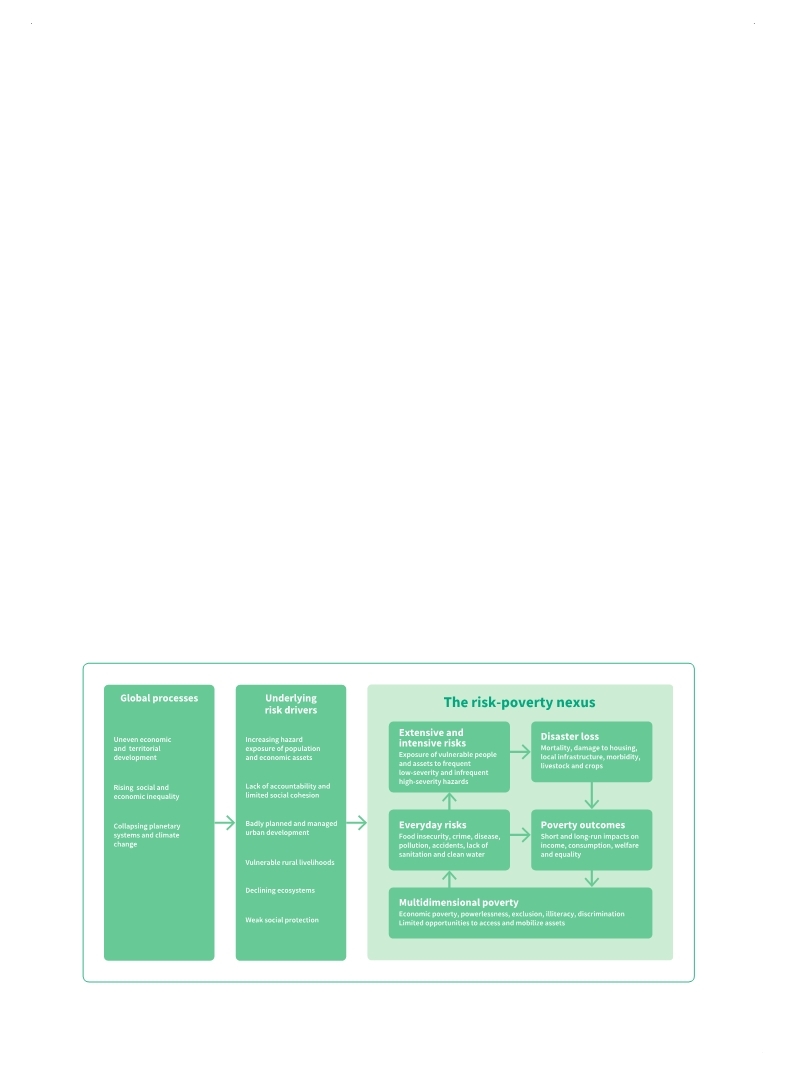 |
Global Assessment Report on Disaster Risk Reduction 2015
Making development sustainable: The future of disaster risk management |
 |
Global Assessment Report on Disaster Risk Reduction 2015
Making development sustainable: The future of disaster risk management |
|
|

186
Part III - Chapter 9
However, as in Calton, disaster risk is shaped not only by income poverty but by a range of social and economic factors that determine entitlements and capabilities (Shepherd et al., 2013
Shepherd, Andrew, Tom Mitchell, Kirsty Lewis, Amanda Lenhardt, Lindsey Jones, Lucy Scott and Robert Muir-Wood. 2013,The geography of poverty, disasters and climate extremes in 2030, Overseas Development Institute, MetOffice and RMS. October 2013.. . Satterthwaite, David and Diana Mitlin. 2014,Reducing Urban Poverty in the Global South, USA and Canada: Routledge Publishing.. . Anderson, Mary. 1994,Disaster Prevention for Sustainable Development, Economic and policy issues. Ch. 3. In Vulnerability to Disaster and Sustainable Development: A General Framework for Assessing Vulnerability. Mohan Munasinghe and Caroline Clarke, eds. Washington, D.C.: The International Decade for Natural Disaster Reduc. . IASC (Inter-Agency Standing Committee). 2006,Women, Girls, Boys and Men: Different Needs, Equal Opportunities, IASC Gender Handbook in Humanitarian Action. December 2006.. . Benson, Lynne and Jon Bugge. 2007,Child-Led Disaster Risk Reduction: A Practical Guide, Save the Children.. . Aldrich, Nancy and William Benson. 2008,Disaster Preparedness and the Chronic Disease Needs of Vulnerable Older Adults, Preventing Chronic Disease. Public Health Research, Practice and Policy, Vol. 5, No. 1 (January).. . Walden, Daniel, Nick Hall and Kelly Hawrylyshyn. 2009,Participation and Protection: Children’s Involvement in Climate Change Debates, IDS In Focus Policy Briefing 13.4. November 2009. Institute of Development Studies.. . UNISDR. 2009a,Global Assessment Report on Disaster Risk Reduction: Risk and Poverty in a Changing Climate, Geneva, Switzerland: UNISDR.. . World Bank. 2010,World Development Report 2010: Development and Climate Change, The World Bank, Washington, D.C.. . Nilufar, Ahmad. 2012,Gender and Climate Change in Bangladesh: The Role of Institutions in Reducing Gender Gaps in Adaptation Program, A summary of ESW Report no. P125705, Paper No. 126/March 2012. Social Development Papers. Social Inclusion.. . Shepherd, Andrew, Tom Mitchell, Kirsty Lewis, Amanda Lenhardt, Lindsey Jones, Lucy Scott and Robert Muir-Wood. 2013,The geography of poverty, disasters and climate extremes in 2030, Overseas Development Institute, MetOffice and RMS. October 2013.. . People who are subject to multi-dimensional poverty are more likely to live in hazard-exposed areas and are less able to invest in risk-reducing measures. As such, conditions of everyday
risk become configured as patterns of extensive disaster risk (Figure 9.2), which in turn lead to accumulations of intensive risk in regions exposed to earthquakes, tropical cyclones and other major hazards.
The lack of access to insurance and social protection mechanisms and the general difficulty of mobilizing assets to buffer losses then means that damage to housing, local infrastructure, livestock and crops feeds back into a range of disaster impacts and poverty outcomes (UNISDR, 2009a
UNISDR. 2009a,Global Assessment Report on Disaster Risk Reduction: Risk and Poverty in a Changing Climate, Geneva, Switzerland: UNISDR.. . Baez, Javier, Alejandro de la Fuente and Indhira Santos. 2009,Do Natural Disasters Affect Human Capital? An Assessment Based on Existing Empirical Evidence, IZA Discussion Paper No. 5164.. . Figure 9.2 The disaster risk–poverty nexus
(Source: UNISDR.)
|
 
Page 1Page 10Page 20Page 30Page 40Page 50Page 60Page 70Page 80Page 90Page 100Page 110Page 120Page 130Page 140Page 150Page 160Page 170Page 176Page 177Page 178Page 179Page 180Page 181Page 182Page 183Page 184Page 185Page 186Page 187->Page 188Page 189Page 190Page 191Page 192Page 193Page 194Page 195Page 196Page 197Page 198Page 199Page 200Page 210Page 220Page 230Page 240Page 250Page 260Page 270Page 280Page 290Page 300Page 310
|
|
 
|
 
|
